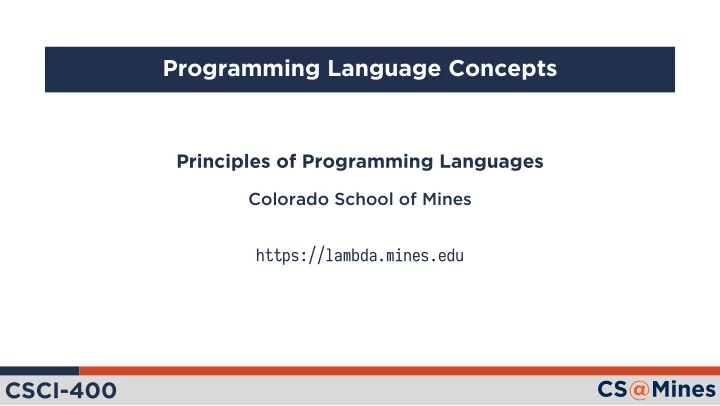

Programming Language Concepts Principles of Programming Languages Colorado School of Mines https://lambda.mines.edu CSCI-400
With your learning group: 1 Share your defjnitions of a programming language. Discuss what each defjnition entails, and whether you think it could be improved. 2 Create one collective defjnition. Got a good one? There will be a chance for you to share with the class. Learning Group Activity CSCI-400
Two Parts to a Language CSCI-400
Design: The language specifjcation; that is, given an input, how should the implementation behave? Implementation: A compiler or interpreter which behaves according to the language design. Example C is a programming language, but GCC is an implementation of the C programming language. Design vs. Implementation CSCI-400
1 Someone tells you a language is fast . Are they referring to the design, or the implementation? Or both? Why? 2 Is it always correct to separate the concepts of design and implementation? When can we get into murky water? Discuss CSCI-400
Abstract Syntax Trees CSCI-400
Consider this simple mathematical expression: We could convert this to a tree structure that represents the same expression: This kind of tree structure which represents the syntax of an expression is called an Abstract Syntax Tree (AST). Abstract Syntax Trees ( 2 + 3 ) × 4 × + 4 2 3 CSCI-400
Since drawing abstract syntax trees is a lot of work, there exists a notation called symbolic expressions (or s-expressions ) that makes it a little easier. This converts to the following s-expression: Symbolic Expressions × + 4 2 3 (* (+ 2 3) 4) CSCI-400
With your learning group, for each math expression, draw an abstract syntax tree, and write out the resulting s-expression. 2 1 Exercise 1 6 × 7 + 8 2 × 3 × 4 3 2 3 + 5 CSCI-400
To get the result from abstract syntax tree, we could write a simple program to do this: A program which does this is called an interpreter . We’ll present a more formal defjnition of this in a few more slides. Evaluating an AST procedure eval(node): if node is a literal then return node otherwise, if node.operator is... +, then: sum <- 0 for each child in node: sum <- sum + eval(child) return sum *, then: ... CSCI-400
You could imagine a program which takes in an AST and creates machine code (pseudocode omitted): This kind of a program is called a compiler . Again, formal defjnition coming soon. Compiling an AST ADD R1 <- 2, 3 (* (+ 2 3) 4) -> MUL R1 <- R1, 4 RETURN R1 CSCI-400
Language Implementation Techniques CSCI-400
Compiler: A computer program which translates a high-level language (such as C) into machine code. Machine Code: A set of instructions which can be directly executed by a CPU. Typically, when we speak of a compiled language , we refer to one which can be compiled to machine code. Compilers which translate to virtual machine bytecode (e.g., Java and Python) are better categorized as interpreted languages . Compiled Languages CSCI-400
Advantages: Disadvantages: Compile time is slow Source code cannot be a part of the input data Examples C, C++, and FORTRAN are generally implemented as compiled languages Compiler Implementations Runtime is fast! CSCI-400
Interpreter: A computer program which reads a high-level programming language and directly executes the instructions of the language itself. An interpreted language is a language designed to be implemented using an interpreter. Discuss What could be the advantages of executing the language directly? Disadvantages? Try and come up with an example of something that could be done with an interpreter model but not a compiler model. Interpreted Languages CSCI-400
implemented as interpreted Figure: Model of a classic interpreter. No need to compile Source code can be a part of input data: you can transmit functions across the network to be run! Disadvantages: Runtime is slow Examples BASIC, PHP, and Perl are generally Advantages: languages complicated. Modern interpreters are slightly more Interpreter Implementations Source Code Input Data Interpreter Computer Result CSCI-400
To speed up the execution of interpreted languages, implementers started getting clever: Interpreted VM Bytecode: Input is lexed, parsed, then translated to bytecode. The bytecode gets optimized, then the low level bytecode is interpreted. Examples: CPython, OpenJDK (Java), Ruby MRI Just In Time Compiler: Source code is compiled as it’s executed, putting machine code on the processor "just in time". Examples: PyPy, LuaJIT, Chrome V8 Advantages include all the benefjts of interpreted languages, with run times occasionally approaching compiled languages. Hybrid Interpreters CSCI-400
Typical Interpreter Structure 1 Lexer: Source Code → Tokens 2 Parser: Tokens → Abstract Syntax Tree (AST) 3 Analyzer (optional): AST → AST (optimized) 4 Evaluator: AST + Context → Result + Context CSCI-400
Cons Cells CSCI-400
A cons cell (short for "construct") is a data structure for which we can build many others from. It consists of two references to other objects. CAR: Contents of the address register CDR: Contents of the decrement register Both can be a reference (e.g., pointer) to anything. Cons Cells: Building Blocks of PL CAR CDR CSCI-400
Suppose we want to represent a list using cons cells. We can take inspiration from linked lists: CAR will be a reference to the list item. CDR will be a reference to the next cell. The last item in the list will have a CDR with the special value NIL . Building Lists using Cons Cells For example, here is a cons cell diagram for the list (42 69 613) : NIL 42 69 613 CSCI-400
Represent the following AST using cons cells: (either done as activity or example on board depending on time) Building Trees using Cons Lists (+ (/ 10 2) (* 3 3)) CSCI-400
until then. Quiz 1 will be held Tuesday, September 4. Topics will be what we cover in class up Quiz Announcement CSCI-400
Recommend
More recommend